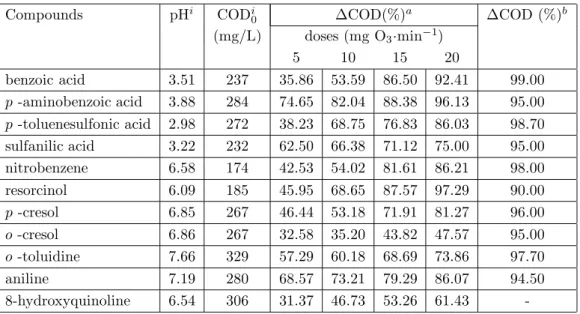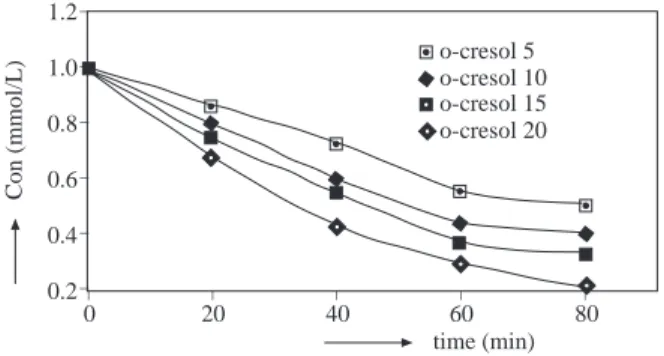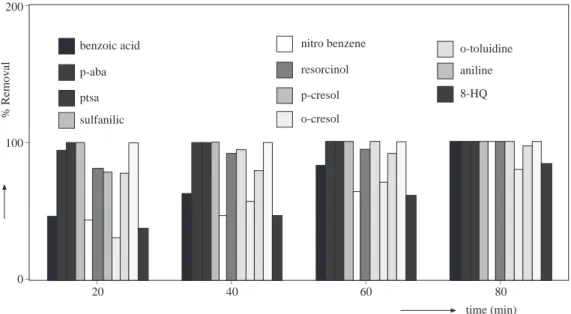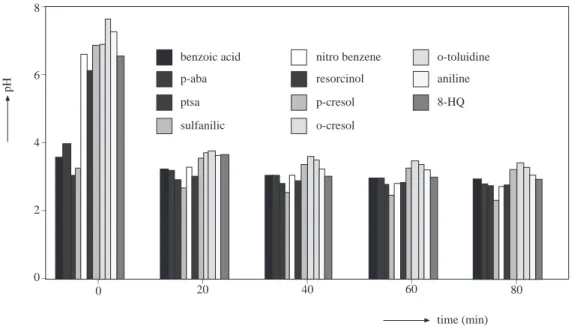c
T ¨UB˙ITAK
Effects of Ozonation on COD Elimination of
Substituted Aromatic Compounds in Aqueous Solution
S¸ermin G ¨UL, Osman SER˙INDA ˘G, Hamit BOZTEPEThe University of C¸ ukurova, Science and Arts Faculty, Department of Chemistry, 01330 Adana-TURKEY
Received 06.03.1996
The chemical oxygen demand (COD) change of various substituted aromatic compounds, namely benzoic acid, p aminobenzoic acid, p toluenesulfonic acid, sulfanilic acid, nitro benzene, resorcinol, p -cresol, o - -cresol, o -toluidine, aniline and 8-hydroxyquinoline were investigated at ozone doses of 5, 10, 15 and 20 mg O3·min−1, respectively. Percent COD removal of initial compounds after ozonation
was compared with reported biodegradation results. The pH change and percent removal of selected compounds were also evaluated in ozone does of 20 mg O3·min−1 up to 80 min. ozonation. The results
showed that high ozone doses are needed to obtain better elimination of initial compounds and also to improve further degradability of the ozonation products.
Introduction
Ozonation of organic solutes in water is of environmental interest. The use of ozone as a disinfectant in water treatment processes is growing continually, as an alternative to chlorination for both drinking water and waste water treatment. Chlorine is a powerful disinfectant with low cost 1; however it is less favourable environmentally due to the formation of chlorinated organic compounds which are considered to be toxic or carcinogenic. Ozone appears to be a more convenient oxidant in comparison with chlorine for waste water treatment by decomposing to O2 and H2O and leaving no by-products that need to be removed 2,3.
In recent years, ozonation processes have been focused on industrial waste water containing waste from sources such as textiles, agriculture, paper and pulp, whereas the early processes dealt with the ozonation of drinking water, that is the improvement of water quality. Ozonation is used widely in Europe and increasingly in the USA, since it is an efficient of degrading aromatic compounds. The aromatic compounds are used in a number of industrial processes, such as the manufacture of chemical solvents, pesticides, polymers, explosives and many other products in every day use. Most aromatics can pose a health hazard and have been designated priority pollutants by the US EPA 4.
Aromatic organic pollutants persistent to biodegradation in surface waters cause serious environmental problems. Yi-Tin 4 has investigated the anaerobic biodegradability of o -cresol, 2,5 -dichloro phenol, 2, 4 -dinitrophenol and benzenesulfonic acid and the results indicated that the degree of biodegradability change is related to applied ozone doses and with functional groups on the benzene ring.
in waste waters as pollutants prompted us to investigate the COD change of such compounds in aqueous systems at various ozone doses.
Materials and Methods
Ozone was produced in a Fisher 501 ozone generator fed with dried oxygen. Ozonation reactions were carried out in a 1.1 L glass reactor with ozone gas passing ozone gas at speeds of 5, 10, 15, 20 mg O3 min−1 at room temperature. The initial concentrations of the aromatic compounds were prepared as 1x10−3 M and the pH values of these solutions were measured on a pH meter without any adjustments Benzoic acid, p -aminobenzoic acid, p - toluenesulfonic acid, sulfanilic acid, nitrobenzene, resorcinol, p - cresol, o -cresol, o -toluidine, aniline and 8 -hydroxyquinoline (Merck) were used without any purification. Chemical oxygen demands were determined according to standard methods 5.
Results and Discussion
Ozone treatments of various aromatic compounds were carried out in order to better understand the elimination of the selected aromatic compounds depending on both the ozone doses and the substituents. Various substituted benzene compounds, namely, benzoic acid, nitro benzene, aniline, sulfanilic acid, p -toluenesulfonic acid, o - toluidine, resorcinol, o -cresol, p -aminobenzoic acid and 8-hydroxyquinoline were selected, all of which showed different reactions to electrophilic attack of ozone in aqueous solution. The COD changes of these compounds after 80 min ozonation at ozone doses of 5, 10, 15 and 20 mg O3·min−1 are given in Table 1.
Table 1. COD % change depending on ozone doses
Compounds pHi CODi 0 ∆COD(%)a ∆COD (%)b (mg/L) doses (mg O3·min−1) 5 10 15 20 benzoic acid 3.51 237 35.86 53.59 86.50 92.41 99.00 p -aminobenzoic acid 3.88 284 74.65 82.04 88.38 96.13 95.00 p -toluenesulfonic acid 2.98 272 38.23 68.75 76.83 86.03 98.70 sulfanilic acid 3.22 232 62.50 66.38 71.12 75.00 95.00 nitrobenzene 6.58 174 42.53 54.02 81.61 86.21 98.00 resorcinol 6.09 185 45.95 68.65 87.57 97.29 90.00 p -cresol 6.85 267 46.44 53.18 71.91 81.27 96.00 o -cresol 6.86 267 32.58 35.20 43.82 47.57 95.00 o -toluidine 7.66 329 57.29 60.18 68.69 73.86 97.70 aniline 7.19 280 68.57 73.21 79.29 86.07 94.50 8-hydroxyquinoline 6.54 306 31.37 46.73 53.26 61.43
-iThe initial values,
aCOD change after 80 min ozonation,
bCOD change after 5 days biodegradation. Values were taken from reference 6.
The results indicate that the degradation is increased with increasing ozone dose. Thus, the change in chemical oxygen demand, ∆ COD, of the initial compounds is increased as a result of the decrease in COD
depending on the organic fragments. The ∆ COD of these compounds were compared with those of the biological degradation results reported by Pitter 6 (Table 1). Pitter’s results were obtained after a 120-hour period of biodegradation. Our results after 80 min ozonation at an ozone dose of 20 mg O3min−1 are in the same range with Pitter’s results, except for o -cresol and o -toluidine.
It has been reported that compounds having -OH or -CH3 groups as ortho or para substituents on the benzene ring are activated to electrophilic attack of ozone 7,8. However, the COD change of o -cresol has been found remarkable smaller than p -cresol due to the steric effect of ortho position that reduces the ring activity. This result is in agreement with those reported for the degradation rates of methyl substituted phenols 9. The COD elimination of o -toluidine and o -cresol at different ozone doses is illustrated in Figures 1 and 2, respectively.
o-toluidine 5 o-toluidine 10 o-toluidine 15 o-toluidine 20. _ _ _ _ __ _ _ _ _ _ time (min) 100 80 60 40 20 0 400 300 200 100 0 COD (mg/L) _ _ _ _ _ _ 100 80 60 40 20 0 COD (mg/L) time (min) o-cresol 5 o-cresol 10 o-cresol 15 o-cresol 20 300 200 100 _ _ _
Figure 1. Influence of ozone doses on COD elimination
of o -toluidine depending on the initial concentrations COD0: 329 mg/L
Figure 2. Influence of ozone doses on COD
elimina-tion of o -cresol depending on the initial concentraelimina-tions COD0: 267 mg/L
In order to see the effect of the substituents on the ring, the COD eliminations of o -cresol and o -toluidine have been compared. As can be seeen in Figure 2, the COD elimination of o -cresol at lower ozone doses (5, 10 mg O3.min−1) is difficult due to the chemical degradation of by-products. It was found that an increase in the ozone dose shortened the degradation time and so COD elimination was improved. This is also clearly shown in Figures 3 and 4, which represent the degradation of o -cresol and o -toluidine, respectively. time (min) 80 60 40 20 0 Con (mmol/L) o-toluidine 5 o-toluidine 10 o-toluidine 15 o-toluidine 20 _ _ _ _ _ _ _ _ _ _ _ _ 1.2 1.0 0.8 0.6 0.4 0.2 0.0 time (min) 80 60 40 20 0 Con (mmol/L) o-cresol 5 o-cresol 10 o-cresol 15 o-cresol 20 _ _ _ _ _ _ _ _ _ _ _ 1.2 1.0 0.8 0.6 0.4 0.2
Figure 3. Degradation of o -cresol (1x10−3M depend-ing on the ozone dose.
Figure 4. Degradation of o -toluidine (1x10−3M de-pending on the ozone dose.
Our results indicated that the amine substituted o -toluidine shows greater COD elimination and faster reduction in initial concentration than does hydroxyl substituted o -cresol due to having a different Hammet substituent constant, which is indicative of the polar effect of the substituents 10.
The percent removal of the studied aromatics after ozonation for 80 minutes at an ozone dose of 20 mg O3.min−1 are shown in Figure 5. In the first 20 minutes of ozonation, 100 % aniline, sulfanilic acid and p -toluenesulfonic acid was removed whereas p - aminobenzoic acid and p -cresol removal took 40 and 60 minutes respectively. After an 80-minute ozonation period, all compounds were removed completely, except 8-hydroxyquinoline and o -cresol, of which 17 and 20.7 %, respectively, remained unchanged. It was found that an 80-minute ozonation period with 20 mg O3.min−1 is sufficient to degradate the compounds at an initial concentration of 1x10−3 M initial concentration with a high percentage of removal.
_ _ _ 200 100 0 time (min) _ _ _ _ 80 60 40 20 % Removal benzoic acid p-aba ptsa sulfanilic nitro benzene resorcinol p-cresol o-cresol o-toluidine aniline 8-HQ
Figure 5. Percentage removals of selected compounds at an ozone dose of 20 mg O3.min−1.
The pH variations of the selected compounds were also measured during the ozonation period. It has been reported 4,11−14 that ozonation has resulted in the formation of various by-products acidic in character which are listed in Table 2.
Table 2. Oxidation products of subtituted aromatic compounds
Compounds Oxidation products References
p -aminobenzoic acid formic acid, oxalic acid, ammonia 13
p -toluenesulfonic acid methylglyoxal, acetic acid, pyruvic acid, 11, 12 formic acid, oxalic acid
o -cresol formic acid, acetic acid, propionic acid, 4
glyoxylic acid, oxalic acid, salicylic acid
resorcinol maleic acid, glyoxylic acid, oxalic acid, 8
formic acid
o -toluidine acetic acid, oxalic acid 13
8-hydroxyquinoline quinolinic acid, nicotinic acid, glyoxylic 14 acid, oxalic acid
The pH change of solutions during ozonation is depicted in Figure 6. o-toluidine aniline 8-HQ benzoic acid p-aba ptsa sulfanilic nitro benzene resorcinol p-cresol o-cresol time (min) pH _ _ _ _ _ _ _ _ _ _ 8 6 4 2 0 80 60 40 20 0
Figure 6. pH variation of selected compounds at an ozone dose of 20 mg O3.min−1.
The results obtained for the substituted aromatic compounds in the acid pH range might be roughly transferable to the pH range 7-8 as regards the biodegradability depending on COD reduction. A complete oxidation of aromatic compounds by ozonation to CO2 practically and economically is not feasible. However one could achieve a complete conversion of initial compound into less toxic products with a high oxidation state where the products are more biodegradable (14).
The results of the ozonation processes of the selected organic compounds in this study, as expected, showed that the response of different substituted organics to the electrophilic attack of ozone is dependent upon the type of substitutent. The results also indicated that the pre-ozonation of waste waters increases the biodegradability of dissolved organic pollutants and improves the effectiveness of further treatment processes. Thus, ozonation treatment could ease when applied prior to other treatment methods.
References
1. F. J. Beltran, J. M. Encinar, J. F. Garcia - Aray, Wat. Res. 24, 1309-1316, (1990). 2. L. Calvosa, A. Monteverdi, B. Rindone and G. Riva, Wat. Res. 25, 985-995, (1991).
3. L. H. Pottenger, E. Gilbert, J. C. Block, P. Hartemann, Ozone: Science and Engineering 2, 25-37, (1980). 4. Y. T. Wang, Wat. Res. 24, 185-190, (1990).
5. APHA, Standard Methods for the Examination of Water and Waste Water, 16th edition, American Public Health Association, Washington, D. C. 1985.
6. P. Pitter, Wat. Res. 10, 231-235, (1976).
7. J. Hoigne and H. Bader, Wat. Res. 17, 173-183, (1983).
8. J. L. Sotelo, F. W. Beltran and M. Gonzalez, Ind. Eng. Chem. Res. 29, 2358-2367, (1990). 9. M. D. Gurol and S. Nekouinaini, Ind. Eng. Chem. Fundam. 23, 54-60, (1984).
10. A. N. Nesmeyanov and N. A. Nesmeyanov Fundamentals of Organic Chemistry, vol 3, 2 nd edition, Mir Publisher, Moscow, 1981.
11. P. Joy, E. Gilbert and S. H. Eberle, Wat. Res. 14, 1509-1516, (1980). 12. H. Boztepe, Do˘ga Bilim Dergisi 8, 171-177, (1984).
13. E. Gilbert, “Congress Catalog of Ozone/Chlorine Dioxide Oxidation Products of Organic
Mate-rials”, No: 78-053924, Ozone Press International 227-242, 1978.



